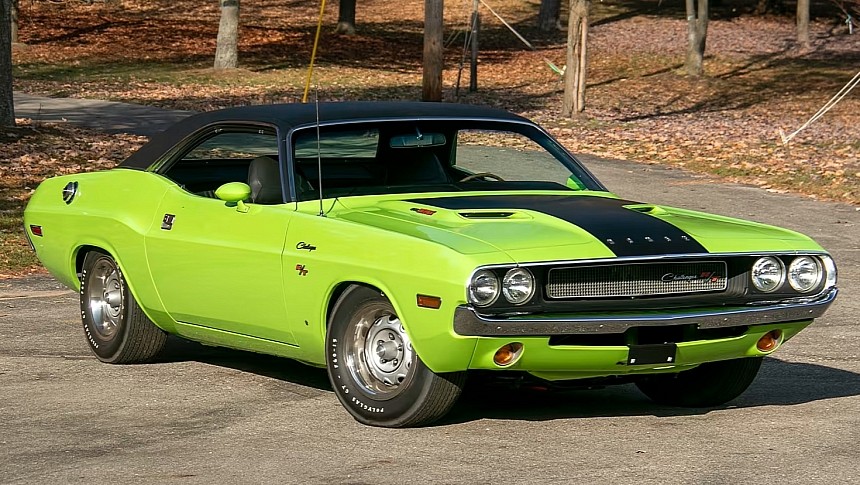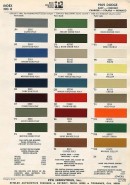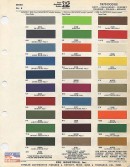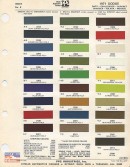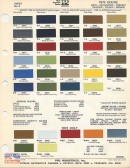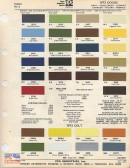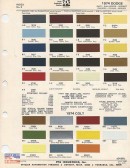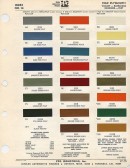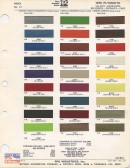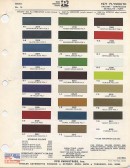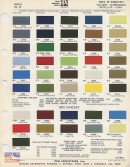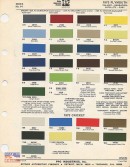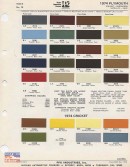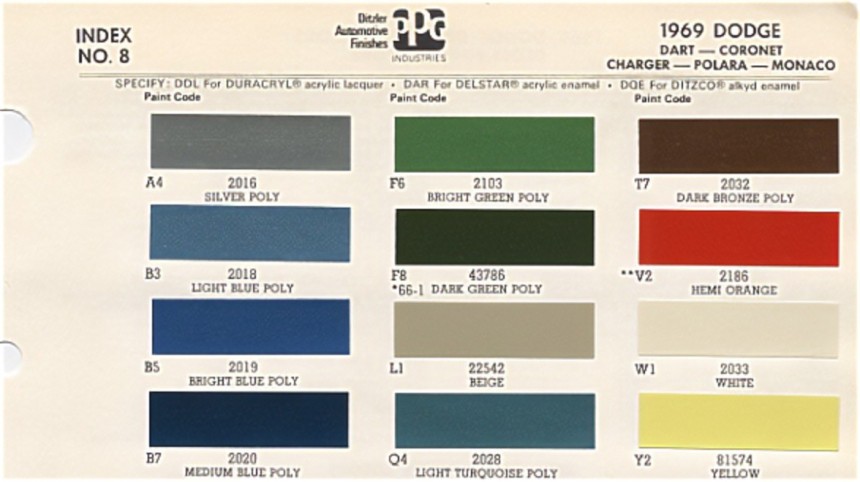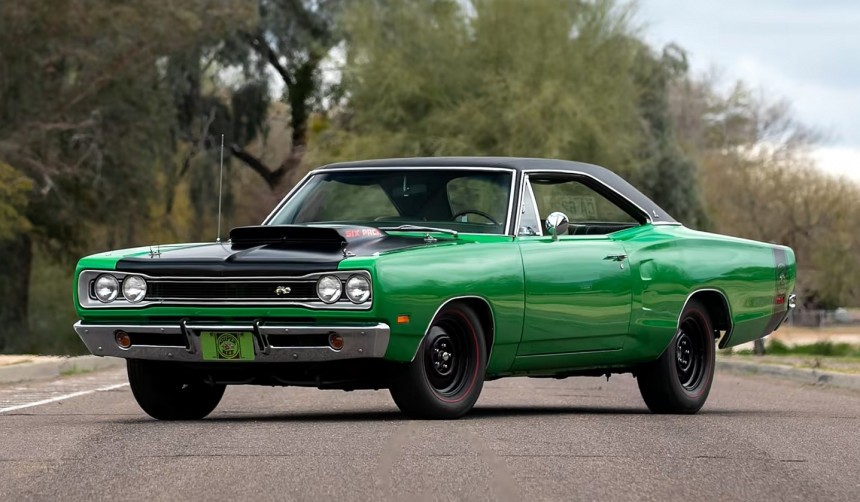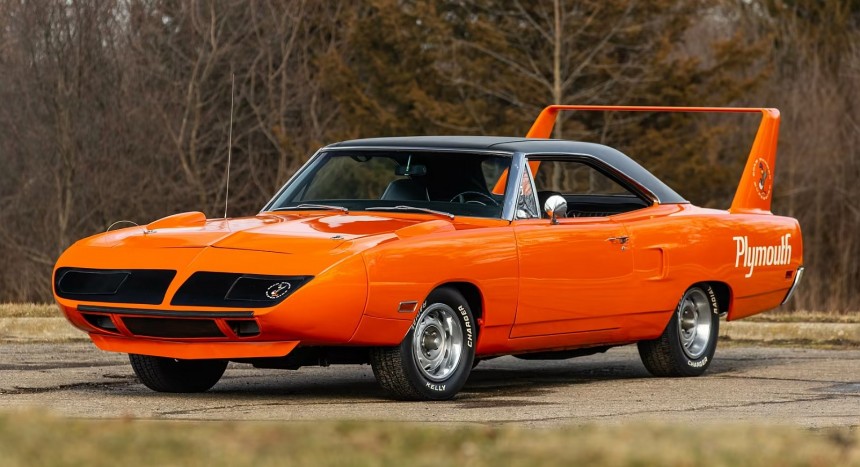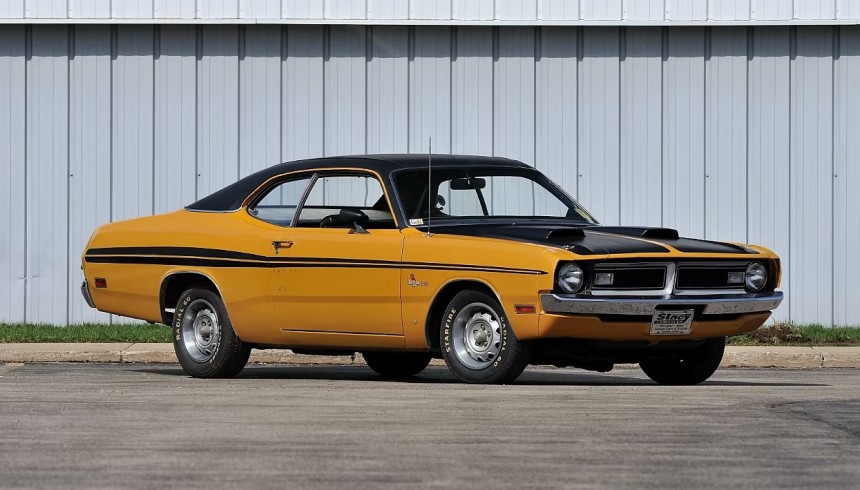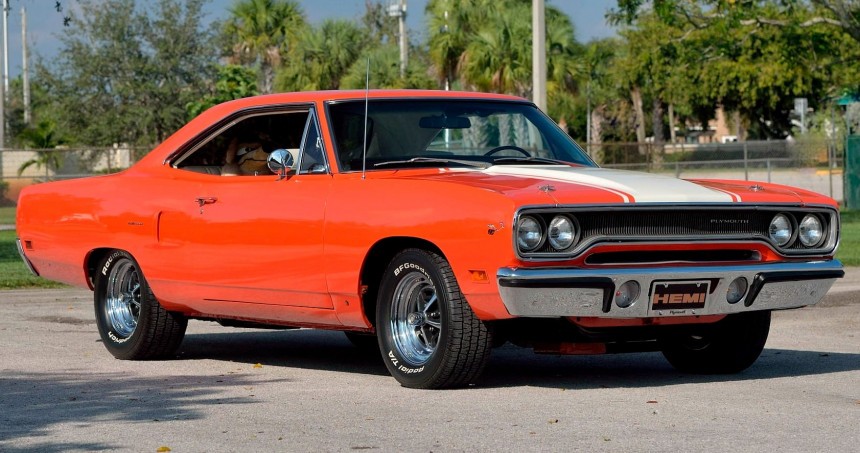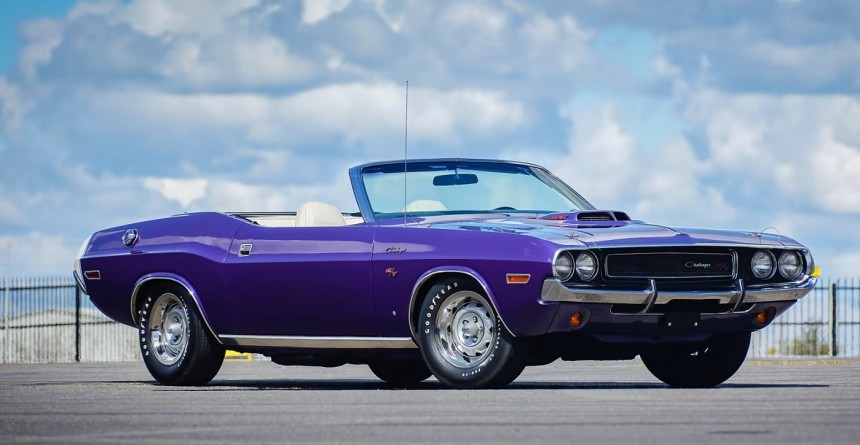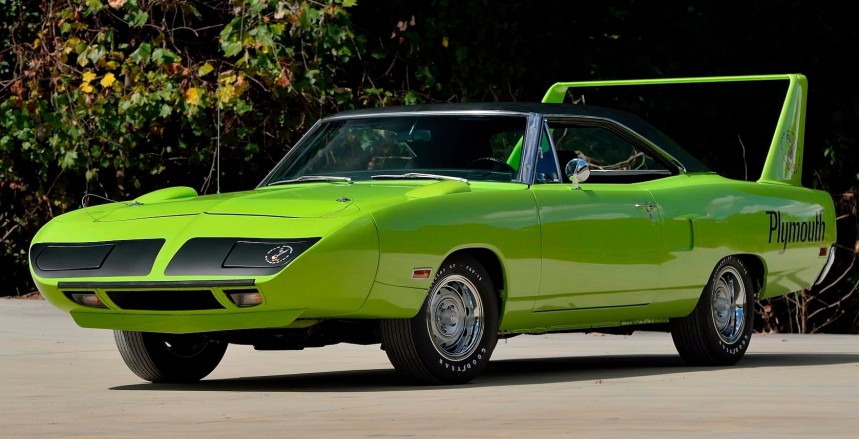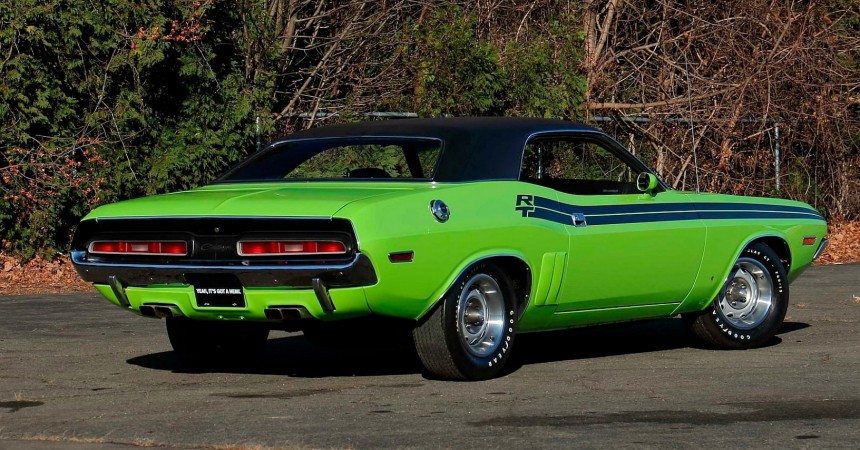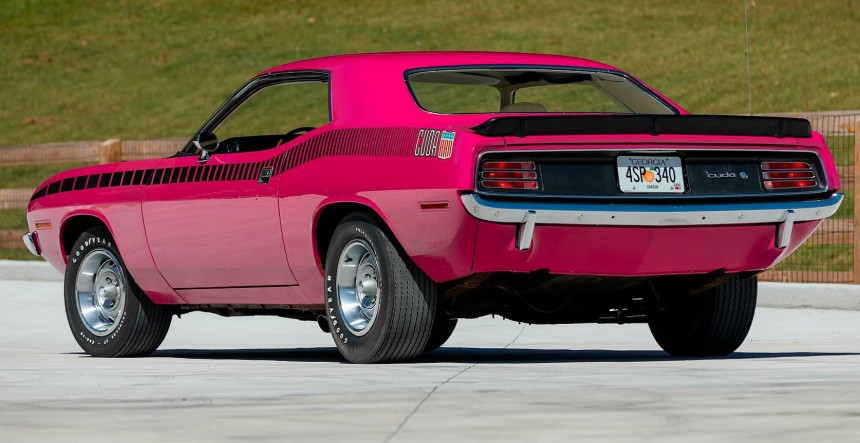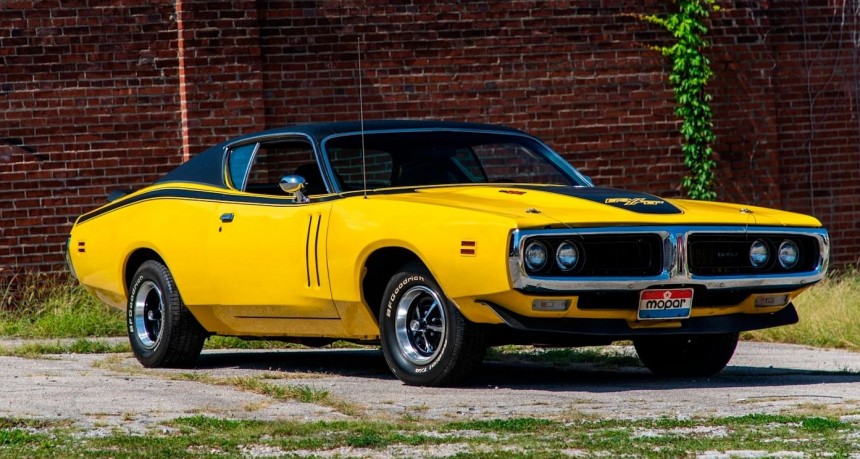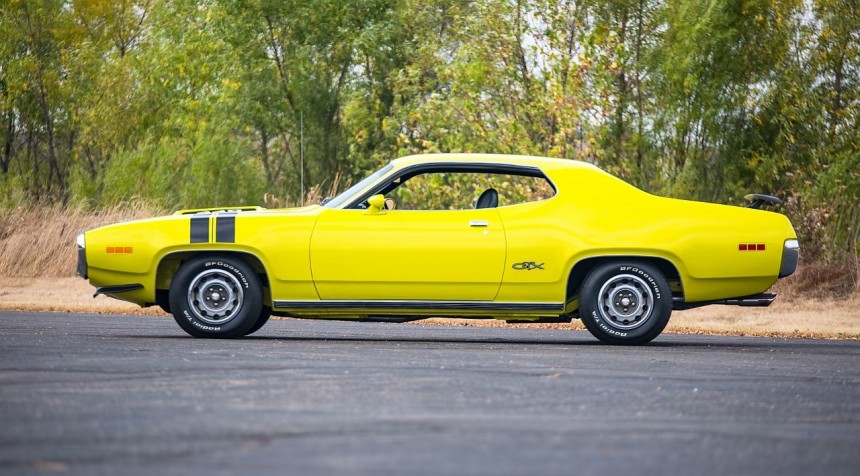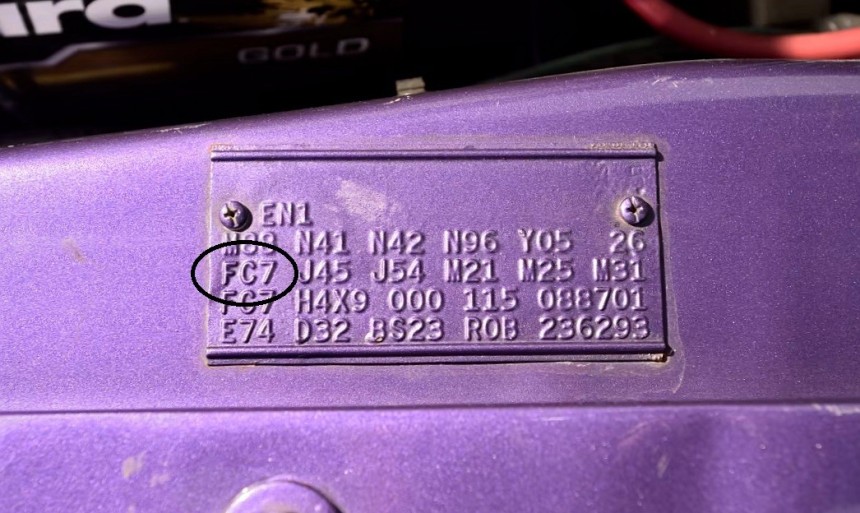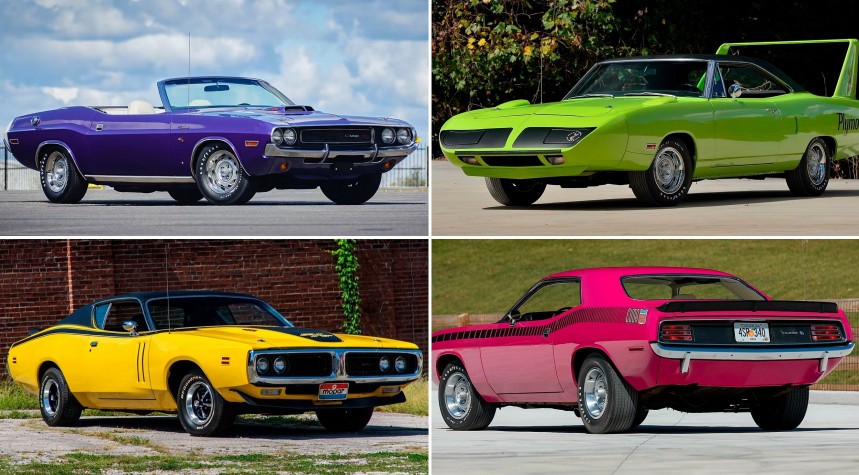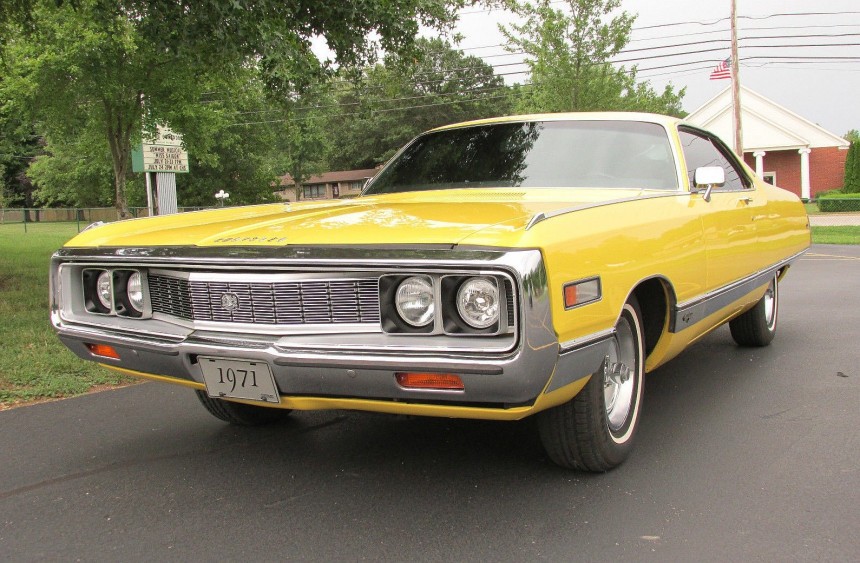There's still an ongoing debate about whether the 1964 Pontiac GTO was the first muscle car or not, but everyone seems to agree that the golden muscle car era lasted from the mid-1960s to the early 1970s. That's when the Big Three introduced some of the most iconic performance vehicles ever made in the US.
Powered by massive big-block V8 engines and often equipped with race-honed features, these rigs became increasingly more powerful and ostentatious toward the late 1960s. And the Chrysler Corporation played a significant role by introducing the High-Impact color palette in 1969.
Launched at a time when the hippie movement was in full swing, and people were chasing individuality, the High-Impact colors became a big hit and graced every single muscle car wearing Dodge or Plymouth badges. More than 50 years later, these vibrant Mopars are highly sought after and prompted Dodge to revive most of the hues.
Chrysler offered 10 High-Impact colors during the golden muscle car era. But they didn't come all at once. These vibrant hues were introduced from 1969 to 1971, and most of them were short-lived, spending only a year or two on the options list. Many were already gone by 1972, and only one survived through 1973, the final year of the muscle car era.
But it's not just the vibrant finishes that set them apart from other Chrysler colors. They also got creative names inspired by fruits and movies, and some used intelligent puns. Let's check them all out below.
Bright Green is one of the first four High-Impact colors Chrysler introduced in 1969. However, unlike Go Mango, Butterscotch, and HEMI Orange, it was available for a limited time in the spring of 1969. Its limited availability makes it among the rarest and most desirable High-Impact colors.
Bright Green was called Rallye Green in the Plymouth catalog, but its seasonal availability also earned it the nickname Spring Green. There's no information on how many cars were ordered in this color, but you'd be hard-pressed to see one at the local cars and coffee meeting.
Moreover, most of the surviving Green Go cars have been repainted, and unrestored vehicles still sporting the original factory paint are rarer than hen's teeth. The green hue was available on most Dodge and Plymouth automobiles in 1969, including the Charger Daytona homologation special. One of these cars sold for more than $400,000 in 2022.
Perhaps the most vibrant shade of orange ever applied on an automobile, Go Mango was also introduced in 1969. The hue found its way on Plymouth's color palette as Vitamin C. Unlike Bright Green, Go Mango remained on offer for the 1970 model year too, so it also became available on the first-generation Dodge Challenger and its corporate twin, the third-gen Plymouth Barracuda.
It was a relatively popular hue at the time, ordered on about 4% of 1970 Barracudas and more than 5% of 1970 Dodge Challengers. Go Mango is also one of the few High-Impact colors revived on modern Mopars. Dodge first brought it back in 2006 on R/T models and again in 2016 on SRT vehicles.
Word has it Go Mango prompted both Ford and Chevrolet to introduce their own flashy orange hues. Ford came up with Grabber Orange, while Chevrolet offered Hugger Orange.
A buttery shade of yellow, Butterscotch (or Bahama Yellow on Plymouths), is not quite as flashy as the other nine colors on this list. It's also a bit more obscure and rarely associated with the High-Impact color palette. But it's still an eye-catching hue when combined with the various stripe packages that Dodge and Plymouth offered at the time.
Chrysler sold the color through 1971, making it one of very few High-Impact paints that survived for more than two years. However, the hue is scarce, and you're more likely to see it on Mopars abandoned at the junkyard rather than on nicely restored examples.
I don't know why because it's a fantastic color if you ask me, but I guess yellow is not very attractive for most muscle car enthusiasts. The fact that it was one of three shades of yellow available at the time probably didn't help either. But I will discuss more about that below.
The fourth High-Impact color introduced in 1969, this hue had a bit of an identity crisis. While Dodge called it HEMI Orange, Plymouth labeled it Tor Red. So was it orange, or was it red? Well, the answer is both because this color is lighter than red but darker than orange. It appears orange in bright light but becomes reddish in dimmer light.
It may sound confusing, but HEMI Orange / Tor Red is one of the coolest High-Impact colors. It was pretty popular, too, and Chrysler kept it on the options list through 1972. That's a whopping four model years.
Not surprisingly, both names returned in modern times as part of the Dodge Heritage Color Collection. However, Dodge revived them as separate colors. While the contemporary HEMI Orange is true to the original hue, Tor Red is a darker, more reddish color.
Arguably the most popular color (by sales volume) from the golden muscle car era, Plum Crazy / In-Violet debuted in 1970. And not only did it grace existing Mopars, but it also arrived just in time for the then-new first-generation Dodge Challenger and third-generation Plymouth Barracuda. They both shared the E-body platform, and both look stunning in the vibrant purple coating.
FC7 was discontinued after only two years on the options list, but that was enough for the hue to develop a cult-like following. This color is more sought-after by collectors, and it can also add a premium over all the other high-impact colors (except for the super-rare Bright Green / Rallye Green). Although Plymouth called it In-Violet, Road Runners and 'Cudas sporting this paint are also called Plum Crazy cars.
The color was revived when the Charger and Challenger returned to showrooms in the 2000s. It has since adorned every single version of the muscle cars, from the R/T to the Hellcat-powered beasts.
The most vibrant High-Impact color in my book, Sublime / Limelight, makes Bright Green seem dull by comparison. It looks great when combined with black stripes and vinyl top and even better when the Mopar in question sports white stripes and top and a matching interior.
Called Sublime by Dodge and Limelight by Plymouth, this color was introduced in 1970 and was removed from the options list before the 1971 order books were opened. Despite its short life, Sublime / Limelight was popular and survived on many E-body and B-body muscle cars, including the wild Plymouth Superbird.
And not only did Sublime return on the modern Charger and Challenger, but it also found its way on the Ram pickup palette for a short while. The brand made 3,000 Sublime-painted pickups during the 2017 model year.
Sublime wasn't the only bright shade of green offered in 1970. The High-Impact palette also included Green Go / Sassy Grass. While not as flashy as Sublime, Green Go was notably brighter than 1969's Bright Green. The color was discontinued in 1971 after only two years on the market.
Unlike Sublime, Green Go works better on muscle cars without vinyl tops or convertibles. But I've also seen a few fetching rigs with green-tinted Mod-Top options.
Dodge revived Green Go in 2017 but also offered a similar hue called Green With Envy before that. And needless to say, the modern Challenger is just as sexy as its 1970s ancestor in FJ6.
Arguably the most controversial color, FM3 was introduced in 1970 as a spring color. But unlike Bright Green, it returned the following year as a special-order option. Dodge called it Panther Pink after the 1963 film. Plymouth went with Moulin Rouge, referring to the famous cabaret in Paris, France.
What made it controversial? Well, many viewed it as too feminine for a muscle car. As a result, it wasn't particularly popular at the time, with only a few drivers opting to be seen driving a pink vehicle. Experts agree that only 0.5% of 1970 Plymouth Barracudas were finished in Moulin Rouge, which accounts for fewer than 250 cars. Likewise, less than 0.5% of 1970 Challengers were ordered in Panther Pink. Similar statistics apply across the entire Mopar range.
Moreover, most of the cars that left the factory in FM3 were repainted by second-hand owners, turning pink Mopars into super rare gems. Did I mention it's my favorite High-Impact hue?
A vibrant shade of yellow, FY1 stands out for a few reasons beyond its flashy nature. For starters, it's one of only two High-Impact colors offered for four years. The other one is HEMI Orange / Tor Red. It's also the only color launched in 1970 that was still available in 1973. Top Banana / Lemon Twist was there to see the end of the golden muscle car era.
Finally, unlike all the other High-Impact hues, FY1 found its way on more than just muscle cars. The color was offered on more mundane automobiles and even utility vehicles. It's a paint that you'll see a lot on early 1970s Dodge Darts and Plymouth Dusters. And it looks gorgeous with white side stripes on a 1972 Dodge Challenger.
Dodge revived the name and the color in 2006 for the four-door Charger. It adorned both the R/T and the limited-edition Daytona.
Introduced in 1971, Citron Yella / Curious Yellow was Chrysler's last High-Impact color. And much like HEMI Orange / Tor Red, it changed hues depending on lighting. A vibrant yellow in bright light, Citron Yella becomes more of a lime green in darker light. Some say it's a hybrid between Top Banana / Lemon Twist and Sublime / Limelight. I think it's a gorgeous color and rounds out my personal Top 3, alongside Panther Pink and Sublime.
GY3 didn't make it beyond 1971, and many speculate that it was discontinued due to the Curious Yellow name used by Plymouth. Specifically, many viewed it as a reference to the 1967 Swedish erotic drama "I Am Curious (Yellow)," which was banned in Massachussets. However, given that the color was introduced some three years after the film, it may be just folklore, and Chrysler may have opted to eliminate it due to not being popular.
Citroen Yella / Curious Yellow is among the rarest High-Impact colors, but much like Butterscotch / Bahama Yellow, it's not particularly desirable.
The second digit indicates the color base. For example, Citron Yella and Top Banana both feature "Y" as the second letter. It stands for yellow as the base color. This also applies to non-High-Impact colors like Citron Gold (FY6), Citron Mist (FY4), and Sunfire Yellow (DY3). Green Go and Sublime also share "J" as the second letter because they have a common green base color. The same goes for Go Mango, which shares the letter "K" with Burnt Orange. The latter is not a High-Impact color.
Finally, the third digit, which is a number, indicates the shade. Since Top Banana includes "1" and Black Velvet ends in "9," it's safe to say these numbers go higher as the shade becomes darker.
I also need to point out that some High-Impact colors may be registered with the code "999" on the fender tag. This code was used, in some cases, for spring colors as well as special-order colors. The latter option allowed customers to select a color discontinued at the end of the previous model year.
Dodge's paint chip charts for 1969, 1970, and 1971 show two High-Impact colors with the code "999." One's Bright Green / Rallye Green, which was supposedly discontinued after only a few months in 1969. The second one is Butterscotch / Bahama Yellow. Strangely enough, the latter was officially available through 1971. Pink Panther / Moulin Rouge was also a "999" coded color in 1971.
On the other hand, 1970 Plymouth Barracuda customers favored Lemon Twist, which accounted for more than 9% of total sales. It was the year's second-most popular hue, tied with Blue Fire and behind Rallye Red. But purple ranked high with Barracuda buyers, too, with 7.4% of 1970 units finished in this shade.
Bright Green / Rallye Green is arguably the rarest High-Impact color. That's mainly because it was only available for a few months in 1969, and most customers weren't even aware of its existence. Panther Pink / Moulin Rouge is the second-rarest color, accounting for less than 0.5% of total sales regardless of the nameplate and model year.
What's your favorite High-Impact color? And which classic Mopar you'd get in that hue? Let me know in the comments below.
Launched at a time when the hippie movement was in full swing, and people were chasing individuality, the High-Impact colors became a big hit and graced every single muscle car wearing Dodge or Plymouth badges. More than 50 years later, these vibrant Mopars are highly sought after and prompted Dodge to revive most of the hues.
10 Eye-Popping Colors for Muscle Car Enthusiasts
Chrysler offered 10 High-Impact colors during the golden muscle car era. But they didn't come all at once. These vibrant hues were introduced from 1969 to 1971, and most of them were short-lived, spending only a year or two on the options list. Many were already gone by 1972, and only one survived through 1973, the final year of the muscle car era.
But it's not just the vibrant finishes that set them apart from other Chrysler colors. They also got creative names inspired by fruits and movies, and some used intelligent puns. Let's check them all out below.
1. EF6 Bright Green / Rallye Green
Bright Green was called Rallye Green in the Plymouth catalog, but its seasonal availability also earned it the nickname Spring Green. There's no information on how many cars were ordered in this color, but you'd be hard-pressed to see one at the local cars and coffee meeting.
Moreover, most of the surviving Green Go cars have been repainted, and unrestored vehicles still sporting the original factory paint are rarer than hen's teeth. The green hue was available on most Dodge and Plymouth automobiles in 1969, including the Charger Daytona homologation special. One of these cars sold for more than $400,000 in 2022.
2. EK2 Go Mango / Vitamin C
It was a relatively popular hue at the time, ordered on about 4% of 1970 Barracudas and more than 5% of 1970 Dodge Challengers. Go Mango is also one of the few High-Impact colors revived on modern Mopars. Dodge first brought it back in 2006 on R/T models and again in 2016 on SRT vehicles.
Word has it Go Mango prompted both Ford and Chevrolet to introduce their own flashy orange hues. Ford came up with Grabber Orange, while Chevrolet offered Hugger Orange.
3. EL5 Butterscotch / Bahama Yellow
Chrysler sold the color through 1971, making it one of very few High-Impact paints that survived for more than two years. However, the hue is scarce, and you're more likely to see it on Mopars abandoned at the junkyard rather than on nicely restored examples.
I don't know why because it's a fantastic color if you ask me, but I guess yellow is not very attractive for most muscle car enthusiasts. The fact that it was one of three shades of yellow available at the time probably didn't help either. But I will discuss more about that below.
4. EV2 HEMI Orange / Tor Red
It may sound confusing, but HEMI Orange / Tor Red is one of the coolest High-Impact colors. It was pretty popular, too, and Chrysler kept it on the options list through 1972. That's a whopping four model years.
Not surprisingly, both names returned in modern times as part of the Dodge Heritage Color Collection. However, Dodge revived them as separate colors. While the contemporary HEMI Orange is true to the original hue, Tor Red is a darker, more reddish color.
5. FC7 Plum Crazy / In-Violet
FC7 was discontinued after only two years on the options list, but that was enough for the hue to develop a cult-like following. This color is more sought-after by collectors, and it can also add a premium over all the other high-impact colors (except for the super-rare Bright Green / Rallye Green). Although Plymouth called it In-Violet, Road Runners and 'Cudas sporting this paint are also called Plum Crazy cars.
The color was revived when the Charger and Challenger returned to showrooms in the 2000s. It has since adorned every single version of the muscle cars, from the R/T to the Hellcat-powered beasts.
6. FJ5 Sublime / Limelight
Called Sublime by Dodge and Limelight by Plymouth, this color was introduced in 1970 and was removed from the options list before the 1971 order books were opened. Despite its short life, Sublime / Limelight was popular and survived on many E-body and B-body muscle cars, including the wild Plymouth Superbird.
And not only did Sublime return on the modern Charger and Challenger, but it also found its way on the Ram pickup palette for a short while. The brand made 3,000 Sublime-painted pickups during the 2017 model year.
7. FJ6 Green Go / Sassy Grass
Unlike Sublime, Green Go works better on muscle cars without vinyl tops or convertibles. But I've also seen a few fetching rigs with green-tinted Mod-Top options.
Dodge revived Green Go in 2017 but also offered a similar hue called Green With Envy before that. And needless to say, the modern Challenger is just as sexy as its 1970s ancestor in FJ6.
8. FM3 Panther Pink / Moulin Rouge
What made it controversial? Well, many viewed it as too feminine for a muscle car. As a result, it wasn't particularly popular at the time, with only a few drivers opting to be seen driving a pink vehicle. Experts agree that only 0.5% of 1970 Plymouth Barracudas were finished in Moulin Rouge, which accounts for fewer than 250 cars. Likewise, less than 0.5% of 1970 Challengers were ordered in Panther Pink. Similar statistics apply across the entire Mopar range.
Moreover, most of the cars that left the factory in FM3 were repainted by second-hand owners, turning pink Mopars into super rare gems. Did I mention it's my favorite High-Impact hue?
9. FY1 Top Banana / Lemon Twist
Finally, unlike all the other High-Impact hues, FY1 found its way on more than just muscle cars. The color was offered on more mundane automobiles and even utility vehicles. It's a paint that you'll see a lot on early 1970s Dodge Darts and Plymouth Dusters. And it looks gorgeous with white side stripes on a 1972 Dodge Challenger.
Dodge revived the name and the color in 2006 for the four-door Charger. It adorned both the R/T and the limited-edition Daytona.
10. GY3 Citron Yella / Curious Yellow
GY3 didn't make it beyond 1971, and many speculate that it was discontinued due to the Curious Yellow name used by Plymouth. Specifically, many viewed it as a reference to the 1967 Swedish erotic drama "I Am Curious (Yellow)," which was banned in Massachussets. However, given that the color was introduced some three years after the film, it may be just folklore, and Chrysler may have opted to eliminate it due to not being popular.
Citroen Yella / Curious Yellow is among the rarest High-Impact colors, but much like Butterscotch / Bahama Yellow, it's not particularly desirable.
High-Impact Paint Codes Explained
The codes used for the High-Impact colors may seem random at first glance, but they actually align with the coding system that Chrysler was using at the time. The first letter of the paint indicates the year the color was introduced. In this case, "E" stands for 1969, "F" is for 1970 colors, and "G" nominates hues launched in 1971.The second digit indicates the color base. For example, Citron Yella and Top Banana both feature "Y" as the second letter. It stands for yellow as the base color. This also applies to non-High-Impact colors like Citron Gold (FY6), Citron Mist (FY4), and Sunfire Yellow (DY3). Green Go and Sublime also share "J" as the second letter because they have a common green base color. The same goes for Go Mango, which shares the letter "K" with Burnt Orange. The latter is not a High-Impact color.
Finally, the third digit, which is a number, indicates the shade. Since Top Banana includes "1" and Black Velvet ends in "9," it's safe to say these numbers go higher as the shade becomes darker.
I also need to point out that some High-Impact colors may be registered with the code "999" on the fender tag. This code was used, in some cases, for spring colors as well as special-order colors. The latter option allowed customers to select a color discontinued at the end of the previous model year.
Dodge's paint chip charts for 1969, 1970, and 1971 show two High-Impact colors with the code "999." One's Bright Green / Rallye Green, which was supposedly discontinued after only a few months in 1969. The second one is Butterscotch / Bahama Yellow. Strangely enough, the latter was officially available through 1971. Pink Panther / Moulin Rouge was also a "999" coded color in 1971.
"The Most Popular" versus "The Rarest"
There's no complete statistic that covers High-Impact color sales across all nameplates, but the general consensus is that Plum Crazy / In-Violet was the most popular hue overall. Purple was particularly favored by 1970 Dodge Challenger buyers, who ordered more than 10,000 units in this color (about 13% of total production). The hue remained highly popular in 1971 but lost first place to Bright Blue.On the other hand, 1970 Plymouth Barracuda customers favored Lemon Twist, which accounted for more than 9% of total sales. It was the year's second-most popular hue, tied with Blue Fire and behind Rallye Red. But purple ranked high with Barracuda buyers, too, with 7.4% of 1970 units finished in this shade.
Bright Green / Rallye Green is arguably the rarest High-Impact color. That's mainly because it was only available for a few months in 1969, and most customers weren't even aware of its existence. Panther Pink / Moulin Rouge is the second-rarest color, accounting for less than 0.5% of total sales regardless of the nameplate and model year.
Did you know that high-impact colors were also available on regular cars?
While High-Impact colors are usually tied to the muscle car segment, they were also available on more mundane Mopars. Dodge also offered them on the Polara and Monaco, while Plymouth made some available across the Fury lineup. Chrysler also offered the 300 and the Newport in hues like HEMI Orange and Lemon Twist, but these cars are tough to find nowadays.Did high-impact colors disappear for good in 1973?
Officially, they did. However, Dodge and Plymouth still had vibrant colors in 1974, albeit without special names. The 1974 Dodge Colt, for instance, was available in Bright Yellow and Sea Green Poly, two hues that resembled High-Impact colors from the years before. The Yellow Blaze offered on Dart, Challenger, and Polara models also had a bit of Top Banana in it. Yellow Blaze was also available on all Plymouth cars sold in 1974, while the Cricket shared Bright Yellow and Sea Green with the Colt.What's your favorite High-Impact color? And which classic Mopar you'd get in that hue? Let me know in the comments below.
